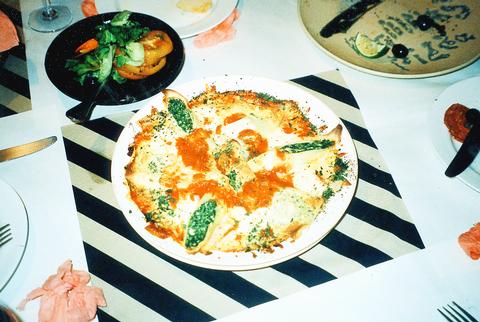While the Taipei suburb of Shulin bares little, if any, resemblance to an Adriatic town, there is one tiny corner in the urban sprawl that is forever Italy.
For the past six years, Italian native Vincenzo Ferrara and his wife, a Shulin local, have been serving up lip-smacking Italian cuisine at their eatery, Mamma Mia.

PHOTO: GAVIN PHIPPS, TAIPEI TIMES
Mamma Mia has thankfully avoided the typical Florentine bordello decor of many Italian restaurants and the menu isn't littered with endless variations of spaghetti. Instead, the interior design and decor are unobtrusive, the space is well-lit and airy and the number of dishes and choice of foods cooked up by Ferrara and his wife are quite remarkable for such a small restaurant. The menu is in fact far more extensive than that of many of Taipei's larger, more fashionable, inner-city Italian joints.
The menu is packed with mouth-watering Italian staples such as spinach and ricotta ravioli (NT$250), vegetable and meat fettuccine (NT$250) and pappardelle (NT$250), anti-pasti and salads. While the menu only lists the basic seafood, vegetarian and meat pizzas (priced between NT$270 and NT$320), the proprietors are happy to make a pizza of your own creation if they have the ingredients in their well-stocked pantry.
One dish that is a must when dining at Mamma Mia is Farrara's spinach and ricotta cheese crepe with mushroom bechamel sauce served on a layer of pasta (NT$220). Also available with meat, the blend of lightly browned crepe, creamy spinach or meat and ricotta stuffing, topped with a smooth and mildly spicy mushroom sauce all bedded on a thin layer of pasta quite literally melts in the mouth.
If you feel your waistline is still in need of expansion after gorging on several of Mamma Mia's savory dishes, then a Sambuca-soaked tiramisu (NT$90) will finish off any meal perfectly.
Of course, being a European eatery, wine is a key feature. Mamma Mia currently offers Chianti (NT$700 per bottle) and Orvato Classico (NT$700 per bottle), a white wine especially imported from Italy for the summer. Alternately, if you have your own favorite wine, then feel free to take it along with you. Corkage is not charged.
While Shulin may seem an odd destination for an evening out, the genuine Italian atmosphere and delicious cuisine cooked up at Mamma Mia is guaranteed to have any diner contemplating a return visit long before they've licked the last speck of tiramisu from their spoon.
As Mamma Mia is as popular with residents of Shulin as it is with those out-of-towners lucky enough to have discovered the restaurant, it is advisable to reserve a table before you make the journey to Shulin.
Information:
Address: 293, Fushing Road, Shulin (台北縣樹林鎮復興路293號)
Telephone: (02)2681-6398
Open: Tuesdays through Sundays. Closed Mondays. Lunch 11:30am through 2pm, dinner 5pm through 10:30pm.
Average meal: NT$350
Details: English menu, major credit cards accepted.

In the March 9 edition of the Taipei Times a piece by Ninon Godefroy ran with the headine “The quiet, gentle rhythm of Taiwan.” It started with the line “Taiwan is a small, humble place. There is no Eiffel Tower, no pyramids — no singular attraction that draws the world’s attention.” I laughed out loud at that. This was out of no disrespect for the author or the piece, which made some interesting analogies and good points about how both Din Tai Fung’s and Taiwan Semiconductor Manufacturing Co’s (TSMC, 台積電) meticulous attention to detail and quality are not quite up to

April 21 to April 27 Hsieh Er’s (謝娥) political fortunes were rising fast after she got out of jail and joined the Chinese Nationalist Party (KMT) in December 1945. Not only did she hold key positions in various committees, she was elected the only woman on the Taipei City Council and headed to Nanjing in 1946 as the sole Taiwanese female representative to the National Constituent Assembly. With the support of first lady Soong May-ling (宋美齡), she started the Taipei Women’s Association and Taiwan Provincial Women’s Association, where she

Chinese Nationalist Party (KMT) Chairman Eric Chu (朱立倫) hatched a bold plan to charge forward and seize the initiative when he held a protest in front of the Taipei City Prosecutors’ Office. Though risky, because illegal, its success would help tackle at least six problems facing both himself and the KMT. What he did not see coming was Taipei Mayor Chiang Wan-an (將萬安) tripping him up out of the gate. In spite of Chu being the most consequential and successful KMT chairman since the early 2010s — arguably saving the party from financial ruin and restoring its electoral viability —

It is one of the more remarkable facts of Taiwan history that it was never occupied or claimed by any of the numerous kingdoms of southern China — Han or otherwise — that lay just across the water from it. None of their brilliant ministers ever discovered that Taiwan was a “core interest” of the state whose annexation was “inevitable.” As Paul Kua notes in an excellent monograph laying out how the Portuguese gave Taiwan the name “Formosa,” the first Europeans to express an interest in occupying Taiwan were the Spanish. Tonio Andrade in his seminal work, How Taiwan Became Chinese,